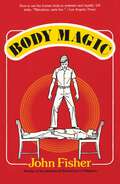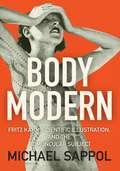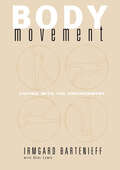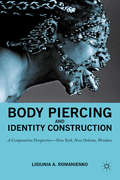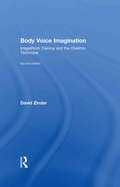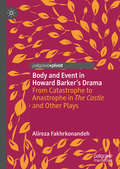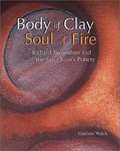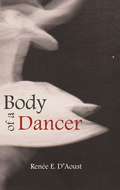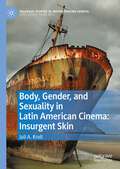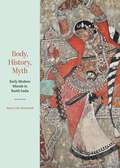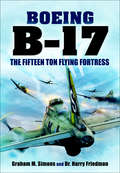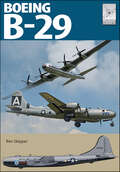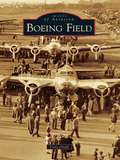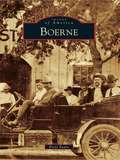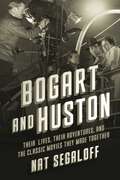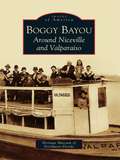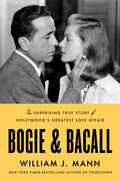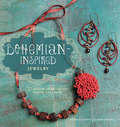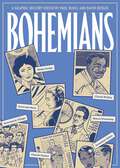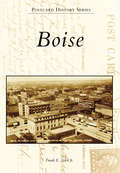- Table View
- List View
Body Language: The Queer Staged Photographs of George Platt Lynes and PaJaMa (Defining Moments in Photography #7)
by Dr. Angela MillerExamines early practices of staged photography in visualizing queer forms of relation. Body Language is the first in-depth study of the extraordinary interplay between George Platt Lynes and PaJaMa (Paul Cadmus, Jared French, and Margaret Hoening French). Nick Mauss and Angela Miller offer timely readings of how their practices of staging, collaboration, and psychological enactment through the body arced across the boundaries of art and life, private and public worlds, anticipating contemporary social media. Using the camera not to capture, but to actively perform, they renounced photography’s conventional role as mirror of the real, energizing forms of world-making via a new social framing of the self.
Body Magic
by John FisherWould you believe that you could ask a full-grown man to hold a penny for you and then tell him to drop it and finds he can&’t, hard as he may try?In what is undoubtedly the most original magic book of our time, John Fisher shows the reader how, with minimal practice, he can use the marvels of the human body to entertain and mystify friends and family, small and large audiences.This book is first of all a delight to read because of the instant education it provides us with about the unknown powers we have in our hands, our eyes, our noses, and our incredible nervous system. In each case, Mr. Fisher shows the easy-to-grasp principle first and then how to put the principle to work in actual tricks.Most magic books require a great deal of study and dexterity. This one enables you to entertain people even before you have finished the book. Moreover, you never have to worry about being prepared, because you always have with you all the miraculous things you need—your hands, your eyes, and the rest of your body.
Body Modern: Fritz Kahn, Scientific Illustration, and the Homuncular Subject
by Michael SappolA poster first printed in Germany in 1926 depicts the human body as a factory populated by tiny workers doing industrial tasks. Devised by Fritz Kahn (1888–1968), a German-Jewish physician and popular science writer, &“Der Mensch als Industriepalast&” (or &“Man as Industrial Palace&”) achieved international fame and was reprinted, in various languages and versions, all over the world. It was a new kind of image—an illustration that was conceptual and scientific, a visual explanation of how things work—and Kahn built a career of this new genre. In collaboration with a stable of artists (only some of whom were credited), Kahn created thousands of images that were metaphorical, allusive, and self-consciously modern, using an eclectic grab-bag of schools and styles: Dada, Art Deco, photomontage, Art Nouveau, Bauhaus functionalism, and commercial illustration. In Body Modern, Michael Sappol offers the first in-depth critical study of Fritz Kahn and his visual rhetoric. Kahn was an impresario of the modern who catered to readers who were hungry for products and concepts that could help them acquire and perform an overdetermined &“modern&” identity. He and his artists created playful new visual tropes and genres that used striking metaphors to scientifically explain the &“life of Man.&” This rich and largely obscure corpus of images was a technology of the self that naturalized the modern and its technologies by situating them inside the human body.The scope of Kahn&’s project was vast—entirely new kinds of visual explanation—and so was his influence. Today, his legacy can be seen in textbooks, magazines, posters, public health pamphlets, educational websites, and Hollywood movies. But, Sappol concludes, Kahn&’s illustrations also pose profound and unsettling epistemological questions about the construction and performance of the self. Lavishly illustrated with more than 100 images, Body Modern imaginatively explores the relationship between conceptual image, image production, and embodied experience.
Body Movement: Coping with the Environment
by Irmgard Bartenieff Dori Lewis"'Irmgard Bartenieff has a profound knowledge of the human body and how it moves. I am delighted that this will now be made available to many more people.'." -- George Balanchine of Director, New York City Ballet"'Irmgard Bartenieff's pioneering work in the multiple applications of Labananalysis has had a transforming influence on many areas of movement training. Her careful and detailed development of the spatial principles into active corrective work has illuminated and altered the training of people as varied as dancers, choreographers, physical therapists, movement and dance therapists, and psychotherapists. Anthropologists and non-verbal communication researchers have found their world view necessarily altered by her fundamental innovations. The field of body/mind work will need to adapt to include her clear working through of basic principles.'." -- Kayla Kazahn Zalk of President, American Dance Guild
Body Piercing and Identity Construction: A Comparative Perspective — New York, New Orleans, Wroc?aw
by Lisiunia A. RomanienkoBased on a fifteen year longitudinal cross-cultural analysis on the role of the body in identity construction process around the world, this analysis provides readers with a comparative theoretical exploration of piercing and other forms of body modification that international communities of defiance use to express their identity.
Body Positive: A Guide to Loving Your Body
by Emily Lauren DickPacked with introspective questions and gorgeous, un-retouched photographs that display the bodies of real, everyday women aimed at teaching young women that every body is beautiful and happiness comes in all shapes and sizes. A Foreword Reviews recommended title for Mental Health Awareness Month
Body Voice Imagination: ImageWork Training and the Chekhov Technique (A\theatre Arts Book Ser.)
by David ZinderFirst published in 2008. Routledge is an imprint of Taylor & Francis, an informa company.
Body and Event in Howard Barker's Drama: From Catastrophe to Anastrophe in The Castle and Other Plays
by Alireza FakhrkonandehThis book explores questions of gender, desire, embodiment, and language in Barker’s oeuvre. With The Castle as a focal point, the scope extends considerably beyond this play to incorporate analysis and exploration of the Theatre of Catastrophe; questions of gender, subjectivity and desire; God/religion; aesthetics of the self; autonomy-heteronomy; ethics; and the relation between political and libidinal economy, at stake in 20 other plays by Barker (including Rome, The Power of the Dog, The Bite of the Night, Judith, Possibilities, I Saw Myself, Fence in Its Thousandth Year, The Gaoler’s Ache for the Nearly Dead, The Brilliance of the Servant, Golgo, among others).
Body of Clay, Soul of Fire: Richard Bresnahan and the Saint John's Pottery
by Matthew Welch Richard Bresnahan"Body of Clay, Soul of Fire" will delight art lovers, potters, and collectors, as well as everyone who is interested in Japanese and Benedictine traditions. Richard Bresnahan is a preeminent American potter and an ambassador for the natural environment. Reared on a farm in North Dakota, he graduated from Saint John's University in Collegeville, Minnesota, and apprenticed as a potter in Japan. Returning to Saint John's, where he is an artist in residence, he built a massive wood-burning kiln, which, with its innovative flame flues and water channels, dwarfs all other North American kilns. By digging his own clay, using local seeds and hulls as glazing materials, and firing with deadfall, Bresnahan also practices a brand of environmentalism worthy of his Benedictine surroundings.
Body of a Dancer
by Renee D'Aoust"A remarkably clear-eyed descent into New York's surreal world of modern dance peopled by the obsessed, dispossessed, sexy, suicidal, brutal, broke, and absurd."-Lance Olsen, author of Nietzsche's KissesThe award-winning writer Renée E. D'Aoust draws from her experiences as a modern dancer in New York during the nineties. Her luminous prose spotlights this passionate, often brutal world. Trained at the prestigious Martha Graham Center, D'Aoust intertwines accounts of her own and other dancers' lives with essays on modern dance history. A dancer's body, scarred, strained, and tough, bears witness to the discipline demanded by the art form. Body of a Dancer provides a powerful, acidly comic record of what it is to love, and eventually leave, a life centered on dance."With exquisite description, absolute honesty, and a clear compelling voice, Body of a Dancer offers an unforgettable account of one artist's bittersweet journey."-Dinty W. MooreRenée E. D'Aoust's essays have been featured as notable essays in Best American Essays in 2006, 2007, and 2009. Her nonfiction work has been included in the anthology Reading Dance, edited by Robert Gottlieb and nominated for the Pushcart Prize. D'Aoust is the recipient of an NEA Dance Criticism fellowship and grants from The Puffin Foundation and the Idaho Commission on the Arts.
Body, Dress, and Identity in Ancient Greece
by Mireille M. LeeThis is the first general monograph on ancient Greek dress in English to be published in more than a century. By applying modern dress theory to the ancient evidence, this book reconstructs the social meanings attached to the dressed body in ancient Greece. Whereas many scholars have focused on individual aspects of ancient Greek dress, from the perspectives of literary, visual, and archaeological sources, this volume synthesizes the diverse evidence and offers fresh insights into this essential aspect of ancient society.
Body, Gender, and Sexuality in Latin American Cinema: Insurgent Skin (Palgrave Studies in (Re)Presenting Gender)
by Juli A. KrollInsurgent Skin: Body, Gender, and Sexuality in Latin American Cinema argues that twenty-first century Latin American cinema about lesbian, feminist, intersex, and transgender themes is revolutionary because it disrupts heteronormative and binary representation and explores new, queer signifying modes.Grounded in feminist and queer theory, Insurgent Skin conjugates film phenomenology and theories of affect and embodiment to analyze a spectrum of Latin American films.The first chapters explore queer signifying in Argentinean director Lucrecia Martel’s Salta trilogy and the lesbian utopia of Albertina Carri’s Las hijas del fuego (2018). Next, the book discusses the female body as uncanny absence in Tatiana Huezo’s documentary Tempestad (2016), a film about gendered violence in Mexico. Chapter Five focuses on intersex films and the establishing of queer solidarity and an intersex gaze. The last chapter examines transgender embodiment in the Chilean film Una mujer fantástica (2017) and Brazilian documentary Bixa Travesty (2018).
Body, History, Myth: Early Modern Murals in South India
by Anna Lise SeastrandThe first major exploration of the mural tradition in early modern South IndiaAn astonishing variety of murals greet visitors to the temples and palaces of southern India. Beautiful in execution and extensive in scope, murals painted on walls and ceilings adorn the most important spaces of early modern religious and political performance. Scene by scene, histories of holy sites, portraits that incorporate historical figures into mythic landscapes, and Tamil and Telugu inscriptions that evoke the imagined topographies of devotional poetry unfold before the mobile spectator. Body, History, Myth reconceives the relationship between art and devotion in South India by describing how the extraordinary sensory experience of a viewing body in motion unfurls a sacred narrative exquisitely designed to teach, impress, and inspire.Anna Lise Seastrand offers new insights into the arts of early modern southern India, bringing to life one of the most culturally vibrant yet least understood periods in Indian art. She shows how temple visitors become active participants in the paintings through their somatic engagement with visual stories and devotional landscapes. Seastrand highlights the significance of textuality in early modern South Asia by examining the status of professional scribes and the prominence given to authorship of religious literature and art. Her insights are presented alongside new translations of the texts that accompany mural paintings.Featuring a wealth of stunning images published here for the first time, Body, History, Myth provides a multidimensional reading of temple art that fundamentally reframes the artistic, intellectual, religious, and political histories of early modern India.
Body, Soul and Cyberspace in Contemporary Science Fiction Cinema: Virtual Worlds and Ethical Problems
by Sylvie MagerstädtBody, Soul and Cyberspace explores how recent science-fiction cinema addresses questions about the connections between body and soul, virtuality, and the ways in which we engage with spirituality in the digital age. <P><P> The book investigates notions of love, life and death, taking an interdisciplinary approach by combining cinematic themes with religious, philosophical and ethical ideas. Magerstadt argues how even the most spectacle-driven mainstream films such as Avatar, The Matrix and Terminator can raise interesting and important questions about the human self and our interaction with the world. <P><P>Apart from these well-known science fiction epics, her analysis also draws on recent works, such as Inception, The Thirteenth Floor, eXistenZ, Aeon Flux, Total Recall (2012), Transcendence and TRON: Legacy. These films stimulate an engaging discussion on what makes us human, the role memory plays in understanding ourselves, and how virtual realities challenge the moral concepts that govern human relationships.
Boeing B-17: The Fifteen Ton Flying Fortress
by Graham M. Simons Dr. Harry Friedman&“Fascinating insight into the early development of the B-17 Flying Fortress . . . undoubtedly outshines other books on this significant WWII aircraft.&” —Air Mail The Boeing B-17 was the first American heavy bomber to see action in World War II when it was supplied to the RAF. The design originated in 1934 when the US Air Corps was looking for a heavy bomber to reinforce air forces in Hawaii, Panama and Alaska. For its time, the design included many advanced features, and Boeing continued to develop the aircraft as experience of the demands of long-distance flying at high altitude was gained. When the United States entered WWII, production of the aircraft was rapidly increased and it became the backbone of the USAAF in all theaters of war. This book describes how it was built and utilizes many hitherto unpublished photographs from the design studio and production lines. It illustrates and explains the many different roles that the aircraft took as the war progressed. Heavy bomber, reconnaissance, antisubmarine, and air-sea rescue operations; there were few roles that this solid design could not adopt.
Boeing B-29 Superfortress (Flight Craft #29)
by Ben SkipperThe B-29 Superfortress was the definitive expression in piston-powered offensive air power. It was designed for an air force that was slowly realizing it needed larger and heavy aircraft to support its operations, especially in the Pacific. Riding on the waves made by the equally ground breaking B-17, the B-29 was a bigger, more capable and more complex platform which incorporated myriad lessons learned from the European air war. It was soon decided to utilize the B-29’s exceptional range of 3,250 miles in the Pacific Theater, where its payload would go on to wreak havoc among the forces of Imperial Japan. As well as military targets, the B-29s of the specially formed 20th Air Force would strike hard against the Japanese home islands, initially from bases in India and China, before following on behind MacArthur’s push towards Japan. It was from the island of Tinian that B-29s would drop atomic bomb over the cities of Hiroshima and Nagasaki. The B-29 was a genuine behemoth of the skies, and its flight endurance would see its ten-man crew provided with rest bunks, remotely operated defensive guns and a tunnel linking the front and rear of the aircraft. It was also tough, capable of using the most basic landing strips, providing they were long enough. As a new aircraft it presented both new and converting pilots with a challenge, notwithstanding the B-29’s high-wing loading. From flying the large aircraft to operating its many systems, the B-29 was as complex as it was large, and each member of the ten-man crew had to know their role and perform it flawlessly to ensure operational efficiency. In the post-war era the B-29 was retained by the USAAF and, from 1948, the USAF as the primary strategic bomber. Indeed, the B-29’s fighting days were far from over and it would go on to see action over the skies of Korea. It would also supplement the Royal Air Force’s bomber capacity while Bomber Command awaited the arrival of the Canberra and its next generation of jet-powered V-bombers. The B-29 has more than earned its place in the halls of aviation fame. It was an aircraft ahead of its time that helped usher in a new age of military aviation and provided a tangible bridge between new and old ways.
Boeing Field (Images of Aviation)
by Cory GraffEven before there were runways, the area south of the city of Seattle was Washington's aviation hub. Charles Hamilton, a daredevil dubbed "Crazy Man of the Air," became the first flyer in the state when he coaxed his Curtiss biplane into the sky over Meadows Racetrack in 1910. He promptly crashed. With the help of William Boeing and his growing aviation company, Boeing Field opened in 1928. In those early days, brave air travelers could hitch a ride along with bags of mail in cold, noisy biplanes. Bigger, better aircraft soon followed, but wartime intervened. Thousands of Flying Fortress bombers emerged from Boeing's Plant 2 at the edge of the airfield and winged off to war. In the years after, Boeing Field served a dazzling array of winged machines--from the smallest Piper Cub to Air Force One.
Boerne (Images of America)
by Brent EvansIn 1849, German "Freethinkers" had been dreaming of a communal utopia, free from oppression by church and state. They settled in Texas on the Cibolo Creek, where Native Americans and Spanish explorers had gone before them. The experiment evolved into a frontier outpost, a stage stop, a health spa, a railhead, a small village, a brief chapter in the Civil War, and a farm and ranch community. Boerne is now a tourist destination and a lovely place to live. This collection of pictures and stories explores what has been amazing, unique, and a little odd about this bend in the Cibolo, as well as the history of local conservation efforts. As the little town of Boerne goes through its inevitable growing pains, it is important to remember its special people and places, and what is worth saving.
Boesinghe (Battleground Ypres)
by Stephen McGrealIn the aftermath of the War, the war-ravaged countryside was restored and the trenches of the Western Front were filled in. 75 years after the War a group of Belgians, known as the Diggers, excavated a classic trench system at Boesinghe, discovering many artifacts as well as remains of the Fallen. One section has been preserved. Boesinghe is a canal village and the opposing sides continually bombarded each other across the wide Yser canal. In the opening phases of the Second battle of Ypres, the Germans used gas ; despite this, the British flank held. Late in the summer of 1917 the Allies launched the Third battle of Ypres and the Guards Division spearheaded the crossing of the canal. They attained their planned objectives but at great cost. The many military cemeteries in the area are poignant reminders of the cost of war even in what some regarded as a quiet sector.
Bogart and Huston: Their Lives, Their Adventures, and the Iconic Movies They Made Together
by Nat SegaloffFrom 1941 to 1953, director John Huston and actor Humphrey Bogart made one classic film after another, from The Maltese Falcon to The African Queen. Here is the story of their close but combative friendship that produced some of the best movies ever made. Every time they made a movie together, they made a classic—or so it seemed for star Humphrey Bogart and writer/director John Huston. Their six collaborations from 1941 and 1953 include many of the "golden age&” hits from Hollywood&’s fabled film legacy: The Maltese Falcon, Across the Pacific, The Treasure of the Sierra Madre, Key Largo, The African Queen, and Beat the Devil. At the same time, both men led fiercely separate lives—except when they were making pictures together. Sometimes they agreed and sometimes they argued, always keeping their eyes on the results. What did each man bring to the collaboration, and how did their six films together reflect their disparate personalities? Their friendship was as dramatic as any of their movies. It survived nine marriages, a world war, the blacklist, leeches, alcohol, and Jack L. Warner. Here is the story of these two legendary talents, their films, their lives, their foes, and their remarkable devotion to each other
Boggy Bayou: Around Niceville and Valparaiso
by Heritage Museum of Northwest FloridaLocated just north of Florida's Gulf Coast, the twin cities of Niceville and Valparaiso nestle side by side along the shores of Boggy Bayou. Although they are now dynamic modern communities, the land they occupy remained a wilderness long after the rest of Florida was settled. After the Civil War, early homesteaders carved out a meager existence by making turpentine, sawing lumber from the pine forests, and harvesting fish from the waterways. In the 1920s, word spread that this region was an unspoiled paradise, so Chicago investors purchased land for development. Photographs taken at the time show the first hard road to Crestview, an early-20th-century bathhouse and waterslide, and formal get togethers at the Valparaiso Hotel. Today the nearby towns of Destin and Fort Walton Beach host millions of tourists, but just across the bridge, Niceville and Valparaiso hold on to their small-town charm.
Bogie & Bacall: The Surprising True Story of Hollywood's Greatest Love Affair
by William J. MannFrom the noted Hollywood biographer and author of The Contender comes this celebration of the great American love story—the romance between Lauren Bacall and Humphrey Bogart—capturing its complexity, contradictions, and challenges as never before.In Bogie & Bacall, William Mann offers a deep and comprehensive look at Lauren Bacall, Humphrey Bogart, and the unlikely love they shared. Mann details their early years—Bogart’s effete upbringing in New York City; Bacall’s rise as a model and actress. He paints a vivid portrait of their courtship and twelve-year marriage: the fights, the reconciliations, the children, the affairs, Bogie’s illness and Bacall’s steadfastness until his death. He offers a sympathetic yet clear-eyed portrait of Bacall’s life after Bogie, exploring her relationships with Frank Sinatra and Jason Robards, who would become her second husband, and the identity crisis she faced.Surpassing previous biographies, Mann digs deep into the celebrities’ personal lives and considers their relationship from surprising angles. Bacall was just nineteen when she started dating the thrice-married forty-five-year-old Bogart. How might that age gap have influenced their relationship? In addition to what she gained, what might Bacall have lost by marrying a Hollywood superstar more than twice her age? How did Bogart, a man of average looks, become one of the greatest movie stars of all time? Throughout, Mann explains the unparalleled successes of their individual careers as well as the extraordinary love between them and the legend that has endured.Filled with entertaining details and thoughtful insights based on newly available records and correspondence, and illustrated with 30-40 photographs, Bogie & Bacall offers a fresh look at this famous couple, their remarkable relationship, and their legacy.
Bohemian Inspired Jewelry: 50 Designs Using Leather, Ribbon, and Cords
by Lorelei Eurto Erin SiegelBohemian-Inspired Jewelry presents fifty beautiful designs that explore the rapidly growing trend of using cords and ribbon in jewelry. Inside this colorful instruction book are clear steps for incorporating these trendy materials into designs. From basic jewelry-making techniques, including stringing, knotting, and wire wrapping, to more advanced steps, such as knotted loops and button clasps, Bohemian-Inspired Jewelry is perfect for all levels of jewelry makers interested in creating beautiful, hip designs.Artists Erin Siegel and Lorelei Eurto excel in maximizing jewelry-making possibilities using a simplicity-focused foundation - simple materials, simple techniques, affordable prices. Joined by several top designers, including Denise Yezbak Moore, Tracy Statler, and Mary Jane Dodd, this duo offers plenty of great projects and inspiration in Bohemian-Inspired Jewelry.
Bohemians: A Graphic History
by David BergerThe nineteenth-century countercultures that came to define the bohemian lifestyle spanned both sides of the Atlantic, ranging from Walt Whitman to Josephine Baker, and from Gertrude Stein to Thelonius Monk. Bohemians is the graphic history of this movement and its illustrious figures, recovering the utopian ideas behind millennial communities, and covering the rise of Greenwich Village, the multiracial and radical jazz world, and West Coast and Midwest bohemians, among other scenes.Drawn by an all-star cast of comics artists, including rising figures like Sabrina Jones, Lance Tooks, and Summer McClinton, alongside established artists like Peter Kuper and Spain Rodriguez, Bohemians is a broad and entertaining account of the rebel impulse in American cultural history.featuring work by Spain Rodriguez, Sharon Rudahl, Peter Kuper, Sabrina Jones, David Lasky, Afua Richardson, Lance Tooks, Milton Knight, and others.The ebook edition is expanded from the paperback edition, and includes additional chapters on the swing music scene, La Boheme and midwest bohemians, as well as expanded material on the Greenwich Village intellectuals, Walt Whitman and Harlem jazz club Minton's Playhouse.
Boise
by Frank E. Aden Jr.Boise was founded on the Oregon Trail in 1863, shortly after the opening of Fort Boise, which was built to protect the gold that had recently been discovered in the Boise Basin around Idaho City. By the late 1800s, Boise had a very large downtown infrastructure, and it saw the addition of many multistoried buildings after 1900. In the late 1960s though the 1970s, Boise experienced a major urban renewal project with many of the historic buildings being torn down to make way for a new downtown mall. Since the 1970s, many new buildings have filled in the lots created by the urban renewal. This book will give readers an idea of what Boise once looked like.

